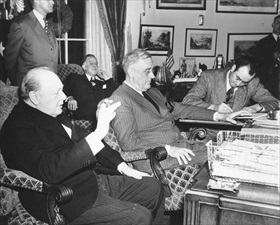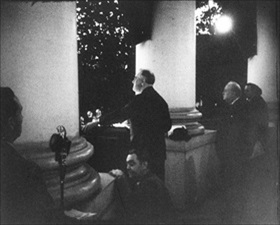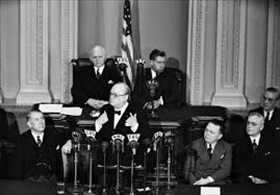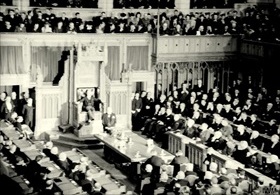CHURCHILL, ROOSEVELT STRATEGIZE IN WASHINGTON
Washington, D.C. · December 22, 1941
On this date in 1941 President Franklin D. Roosevelt, British Prime Minister Winston Churchill, and their respective chiefs of staff assembled in Washington, D.C., for their first strategic conference as combatants-in-arms. The First Washington Conference, codenamed Arcadia, was the second face-to-face meeting (there would be nine in all) between the two English-speaking leaders, the first having been a four-day meeting the previous August off the coast of Newfoundland, Canada. August’s Placentia Bay Conference (or Atlantic Conference as it was also known) produced a seminal agreement on war aims between a still-neutral America and Great Britain, which had been at war with Nazi Germany since September 1939.
Secretly leaving England on December 12, 1941, aboard the new British battleship HMS Duke of York, Churchill arrived as guest of the White House ten days later. Churchill’s absence in England had been noticed by an astute Washington-based newspaper correspondent, who hinted to readers back home in Toledo, Ohio, on December 20 that a meeting of world leaders was in the works. (True.) Nevertheless, Churchill’s upcoming visit was kept mostly a secret until he and his entourage arrived off the Virginia coast on December 22.
Churchill’s American host had at first resisted the British prime minister’s cable requesting a bilateral meeting at “the highest executive level.” Because the British cable arrived only a day after both the U.S. and Great Britain had declared war on Axis powers Japan, Germany, and Italy, Roosevelt worried that he and his staff needed more time to come up to speed on the rapidly unfolding global events; however, the president abruptly changed his mind after learning the Japanese had sunk the battleship HMS Prince of Wales and the battle cruiser HMS Repulse off the east coast of British Malaya.
A prime objective of Churchill during his stay in the U.S. capital was to have the Roosevelt administration commit itself to a “Europe first” strategy; namely, a recognition by potentially the most powerful nation on earth that to win the war against the Axis meant defeating Nazi Germany first and foremost. Out of three weeks of strategizing came the agreement to combine Allied military resources under one command in the European Theater of Operations (ETO). Six months later, on June 8, 1942, the U.S. Department of War officially established ETOUSA, placing U.S. Gen. Dwight D. Eisenhower at its head, with responsibility for planning the eventual reconquest of Europe.
Churchill, Roosevelt, and Advisers Strategize at the First Washington Conference, December 22, 1941, to January 14, 1942
 |  |
Left: The day after his arrival in Washington, D.C., a Tuesday, December 23, 1941, Prime Minister and Minister of Defense Churchill presided over a “war conference” attended by British Commonwealth representatives from Canada, South Africa, Australia, and New Zealand. Later in the afternoon Churchill joined President Roosevelt in a joint press conference for roughly 200 journalists and broadcasters in the Oval Office of the White House. When Roosevelt introduced his guest, he suggested that Churchill rise from his seat to give his audience a better view. Climbing on a chair to be seen better, Churchill was greeted with loud and spontaneous applause and cheers, the first such outpouring at a presidential news conference. Churchill’s wit charmed everyone. Asked how long he thought it would take to win the war, he quipped, “If we manage it well, it will only take half as long as if we manage it badly.”
![]()
Right: After nightfall on Christmas Eve, December 24, Churchill (right in photo) and Roosevelt stepped onto the White House South Portico for a ceremonial lighting of the national Christmas tree on the White House lawn. Before a crowd of 20,000 onlookers and a nationwide radio audience in the millions, the two statesmen made clear the principals for which they had now committed their nations to a war that would engulf much of the world in the coming years. After breakfast the next morning the President, the First Lady, and Churchill attended a Christmas service at nearby Foundry Methodist Church, where they sang Christmas carols, including “O Little Town of Bethlehem,” a carol Churchill had never heard before.
 |  |
Above: The day after Christmas, December 26, a Friday, Churchill became the first British prime minister to address a joint session of the U.S. Congress (left photo), delighting its members when he remarked shortly into his speech: “I cannot help reflecting that if my father had been American and my mother British, instead of the other way round, I might have got here on my own.” Three days later he left by train for Ottawa, Canada, where he addressed the Canadian Parliament in English and French on December 30, 1941 (right photo, Churchill standing in center). After a stay of just over three weeks in North America, Churchill and his staff of military and civilian advisers embarked for England, having spent much of their time making plans for pursuing the war against the Axis powers.
Winston Churchill’s Address to the U.S. Congress, December 26, 1941
![]()

 History buffs, there is good news! The Daily Chronicles of World War II is now available as an ebook for $4.99 on Amazon.com. Containing a year’s worth of dated entries from this website, the ebook brings the story of this tumultuous era to life in a compelling, authoritative, and succinct manner. Featuring inventive navigation aids, the ebook enables readers to instantly move forward or backward by month and date to different dated entries. Simple and elegant! Click
History buffs, there is good news! The Daily Chronicles of World War II is now available as an ebook for $4.99 on Amazon.com. Containing a year’s worth of dated entries from this website, the ebook brings the story of this tumultuous era to life in a compelling, authoritative, and succinct manner. Featuring inventive navigation aids, the ebook enables readers to instantly move forward or backward by month and date to different dated entries. Simple and elegant! Click 











